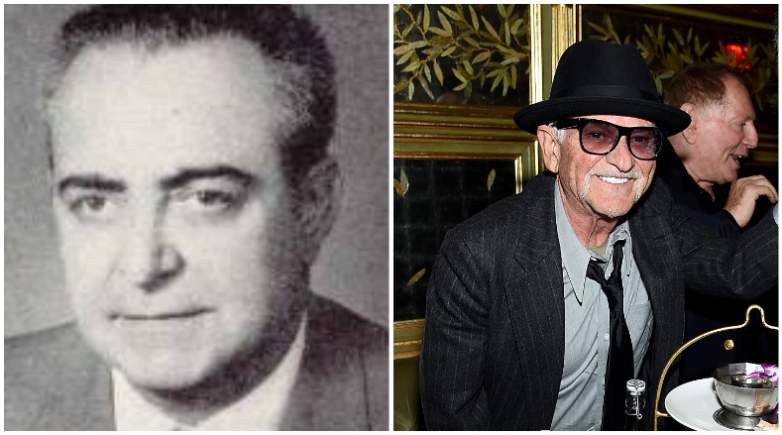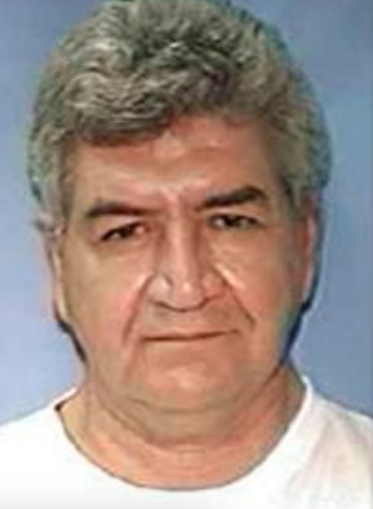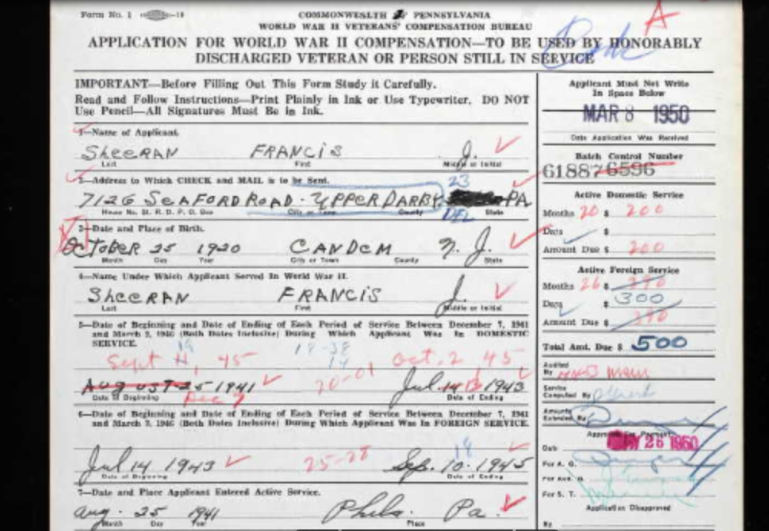
Wikimedia Commons/Facebook Frank Sheeran's ring has a back story. In this photo, Russell Bufalino is on left and Sheeran on right.
The new Martin Scorsese movie, The Irishman, opens with a scene showing Teamster Frank Sheeran wearing a prominent gold ring. Frank is an old man sitting in a nursing home, lamenting the past, and the camera prominently shows the ring. What’s the meaning of it, though? (Warning: Since the movie sticks pretty closely to real life, there will be spoilers for it in this article.)
In the movie, Robert De Niro plays Sheeran, the Delaware union boss who claimed in real life that he murdered Teamsters boss, Jimmy Hoffa, who vanished in 1975 while on a trip to Detroit to meet two mobsters. The real Sheeran was no stranger to the mob; he was a close associate of Pennsylvania crime boss Russell Bufalino, who is played by Joe Pesci in the Netflix film. As he appears in the film, the real Bufalino was a quiet, unassuming man whose real power went unnoticed by the public at large. However, he was one of the United States’ most influential Mafia bosses. In real life, Sheeran claimed that Bufalino ordered him to kill Hoffa, even though Hoffa was Sheeran’s friend. The mob boss had soured on the union boss for a variety of reasons, among them concern that the mob would lose access to the Teamsters’ pension fund.
Bufalino is critical to the story of the ring. He gave it to Sheeran.
The Irishman is based on the 2004 biography of Sheeran’s life called I Heard You Paint Houses by writer Charles Brandt. Some people don’t believe the confession, but it’s plausible; he clearly was in the circle that most people think was responsible for the hit. When they first met, Sheeran says in the book that Jimmy Hoffa told him “I heard you paint houses.” He said yes and added: “I do my own carpentry work too.” That means you shoot people in mob hits and then get rid of the bodies yourself.
Here’s what you need to know:
The Ring Is Designed to Show Sheeran’s Closeness to Russell Bufalino

GettyRussell Bufalino (l) in real life and actor Joe Pesci from The Irishman.
In the Brandt book, Sheeran explains how he acquired the gold ring. The Brandt book quotes Sheeran as calling Russell Bufalino “the other one of the two greatest men I ever met.” His favorite song was “Spanish Eyes.” The famous Five Families of New York sought his counsel. He was a Sicilian immigrant.
In the book, Sheeran says that Russell presented Sheeran “with a gold ring that he had made up special for just three people – himself, his underboss, and me.” It was described as having a “big three-dollar gold piece on top surrounded by diamonds.”
Bufalino was “big in the jewelry-fencing and cat-burglar world” and a silent partner in New York Jewelry stores, the book says. Sheeran was still wearing the ring in his nursing home. Known as “McGee” and the “Old Man,” Russell’s garment businesses served as the front.
In the Netflix movie, the ring also plays a prominent role. Made of three-dollar liberty coins from the 1880s, Russell tells Sheeran in the movie that only three exist in the world, and that the ring symbolizes the fact that Sheeran has moved into Bufalino’s inner sanctum. Bufalino has a ring and Angelo Bruno, another crime boss, has a third. That’s a deviation from real life. Angelo Bruno, in real life, wasn’t Bufalino’s underboss. Bruno was the boss of the Philadelphia mob family. Sheeran wrote in the book that he also wore a ring with the birthstones of each of his four daughters.
So who had the third ring?
In the book, the author says that Big Bill D’Elia was an underboss who became godfather of the Bufalino family when Russell died. In 2006, he was indicted for money laundering. He was Russell’s nephew and daily companion.
In 1972, Russell “made up three diamond-encrusted three-dollar gold-coin rings for himself, for Frank, and for a third person whose identity I’d left out of the book. These rings signified an inner circle of three,” Brandt wrote. But he added an update to the book identifying the third ring holder.
Billy had the third ring, Brandt wrote.
As late as 2010, the Morning Call was reporting on the Crime Family. The newspaper identified William D’Elia as then “the reputed head of the Bufalino crime family,” and said he was being held in a federal prison in Arizona, where he was serving a 9-year sentence meted out in 2008 for money laundering and witness tampering conspiracy charges.
The “Scranton crime boss” was brought down by a mob informant later said to have committed suicide, Morning Call reported in 2012.

MugshotWilliam D’Elia
In 1991, Sheeran had introduced Brandt to Billy, a “tall, easygoing man.” Frank had insisted that Brandt not use Billy’s name in the book.
The Bufalino Crime Family had been in Pennsylvania for a century, dating back to the 1880s, when Bufalinos moved from Sicily, Italy to the Pittston area of Luzerne County. Russell was born Rosario Albert Bufalino on October 29, 1903 in Sicily, a Pennsylvania Crime Commission report says. He became the boss of the northeastern Pennsylvania Cosa Nostra Family in 1959 and one of the nation’s “most ruthless and powerful organized crime figures,” according to the Commission report.
The book says Bufalino didn’t want Jimmy to run for union president again. Both were short men who were “solid muscle from head to toe.” Sheeran was supposed to be in Detroit for Bill Bufalino’s daughter’s wedding.
The book says Bill Bufalino, a lawyer featured in the Netflix movie, was not a relative of Russell but Russell let him say they were cousins to help his career. He had a Grosse Pointe mansion with a waterfall in the basement. He called Russ and told him that two other mobsters – Tony Jack (Giacalone) and Pro (Anthony Provenzano) were meeting with Jimmy Hoffa in Detroit. That set the plan in motion.
Russ was “very spry,” and born in Sicily but “spoke perfect English.” He was married to wife Carrie, but they didn’t have children in real life, as the movie also shows. Russell said to Sheeran of Jimmy, “Your friend made one threat too many in his life… there won’t be a body. My Irishman, we did all we could for the man. Nobody could tell that man what it is. We get into Detroit together Wednesday night.”

Pictured: Frank Sheeran and his first wife, Mary, along with their three daughters: Peggy, Dolores, and MaryAnne.
Sheeran said that, of all of the crime bosses he met, Russell’s “mannerisms and style” most fit Marlon Brando in The Godfather. Meanwhile, Hoffa was “as famous as Elvis.”
The book explains the bad blood between Tony Pro and Hoffa, saying that Jimmy “wanted the little guy dead,” describing Tony Pro as a “made man and a captain in the Genovese family in Brooklyn” who used to be a “Hoffa man” but was now against Hoffa taking back control of the union. In prison, they’d almost come to blows in a dining hall, and Tony Pro was upset that Hoffa wouldn’t ensure he could retain his pension.
Sheeran described Pro as someone who would “kill you for nothing” and ran a Teamsters Local in the area now featured on the Sopranos.
The Brandt book describes Sheeran as a “witty Irishman…raised a devout Catholic…a tough child of the Great Depression; a combat-hardened hero of World War II…”
Frank Sheeran Was a Truck Driver, a World War II Veteran, and a Mob & Jimmy Hoffa Associate
News articles from the 1970s and 1980s make it clear that Sheeran was acquainted with both Hoffa and Bufalino, who introduced Sheeran to the labor leader. Sheeran was, indeed, known as “The Irishman” or “Big Irish Frank Sheeran.”
The book jacket explains that he “In the course of nearly five years of recorded interviews Frank Sheeran confessed to Charles Brandt that he handled more than twenty-five hits for the mob, and for his friend Hoffa. Sheeran learned to kill in the U.S. Army, where he saw an astonishing 411 days of active combat duty in Italy during World War II. After returning home he became a hustler and hit man, working for legendary crime boss Russell Bufalino.”
The book claims that the real-life Sheeran killed Hoffa: “Eventually he would rise to a position of such prominence that in a RICO suit then-U.S. Attorney Rudy Giuliani would name him as one of only two non-Italians on a list of 26 top mob figures. When Bufalino (played by Joe Pesci on Netflix) ordered Sheeran to kill Hoffa, he did the deed, knowing that if he had refused he would have been killed himself.”
According to The Smithsonian, the real Sheeran was an Irish-Catholic WWII veteran and truck driver. He did “small jobs” for Bufalino. He claimed in the book that he was the “right-hand” man of Jimmy Hoffa (played on Netflix by Al Pacino). He was the son of Thomas Francis Sheeran, an Irish-American painter in Philadelphia, and Mary Hanson, who was of Swedish descent. Here’s his application for World War II veterans’ benefits. He used his given name, Francis J. Sheeran, on that application.

Frank Sheeran WWII veterans’ compensation application.
In August 2019, Bill Tonelli wrote an article in Slate Magazine called “The Lies of the Irishman.” The article calls the real Sheeran “a second-stringer—a local Teamsters union official.”
He “hung around with mobsters,” stood 6 foot 4 inches tall, and “died in obscurity, in a nursing home, in 2003,” Tonelli wrote. Sheeran told Brandt that he killed both Hoffa and mobster and Colombo family member Joe Gallo. Tonelli doesn’t buy it in either case. He’s not alone.
However, Sheeran’s account is plausible. People who think someone else pulled the trigger tend to attribute the Hoffa slaying (he was declared dead legally, although his body was never found) to a small group of Detroit and Pennsylvania mobsters, including Bufalino, Giacalone, and Provenzano. Sheeran was deeply affiliated with them all.
In the book, Sheeran said that bosses and captains “sent a guy to whack you who was your friend” because they could get “close to you in a lonely spot.” Also any evidence left could be more easily explained. He was Hoffa’s friend and says that Hoffa mistakenly thought that Sheeran was there for his protection. He thought he was meeting members of the Detroit and Pennsylvania mob in a Detroit house, but ended up with a bullet in the head instead. Sheeran says he delivered it.
A 1981 article described Sheeran as “the gray-haired paunchy old man who emerged from federal court with a labor racketeering conviction.” He had money troubles and health issues by then, including a back problem that “caused him to carry a cane to court and wear a corset at home.”
The article said that Sheeran’s biggest worry was that the government thought he might know who killed Hoffa. It says that “Sheeran was in Detroit the same weekend Hoffa took a final trip.”
Eight years before he had said, “I’ll be a Hoffa man till they pat my face with a shovel and steal my cufflinks.”
A 1981 News Journal article said that he was once called a “union goon.” In 1996, The Daily Item newspaper in Pennsylvania ran an Associated Press article that described Sheeran as “Big Irish Sheeran, a former Teamster boss and Hoffa bagman.”
By 1982, the Morning News in Wilmington, Delaware, was calling “Big Frank Sheeran” the “former Teamster leader and independent businessman.”
At age 74, he was released from prison after serving 13 years in the second racketeering conviction.
He was described as a “dear personal friend” of Hoffa but also “for years a prime suspect in his boss’ disappearance.
In 2005, the Detroit Free Press ran a column by Brandt who indicated that the “truth is that the Jimmy Hoffa mystery is solved by the confession of Frank (The Irishman) Sheeran as detailed in my book.”
He wrote: “Sheeran was a close confidant of Hoffa and was forced to kill his friend and mentor by his godfather, Russell Bufalino.”
Sheeran told Brandt, “If I had said no to Russell, Jimmy would have been just as dead and I’d have gone to Australia with him.”
The article said that Sheeran was “raised a devout Catholic” and suffered from guilt. Brandt wrote that, after their “last taping session,” Sheeran stopped eating “and was dead in six weeks at 83.”
READ NEXT: The Real Story of Tony Pro.
Comments
Frank Sheeran’s Ring in The Irishman: What Does It Mean?